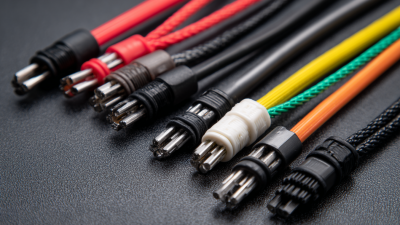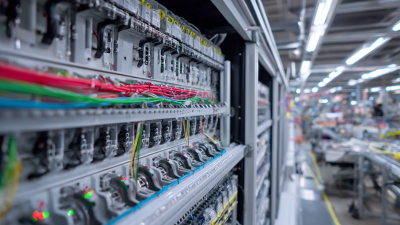In today's rapidly evolving manufacturing landscape, efficient wire harness assembly techniques are paramount for optimizing production processes and ensuring product reliability. According to a report by MarketsandMarkets, the global wire harness market is projected to reach USD 75.28 billion by 2025, driven by the increasing demand for complex electrical wiring in industries such as automotive, aerospace, and consumer electronics. As manufacturers strive to meet stringent quality standards and enhance operational efficiency, adopting the best practices in wire harness assembly becomes essential. This blog explores the ten best techniques that not only streamline the assembly process but also contribute to improved safety and performance in final products. Leveraging these techniques can significantly impact productivity and lead to greater profitability in an increasingly competitive market.

In the fast-paced world of wire harness assembly, precision is not just a preference; it's a necessity. According to industry statistics, the defect rates in wire harness assemblies can range from 15% to as high as 25%, depending on the manufacturing process and level of expertise involved. This high rate of defects can lead to significant financial losses and safety hazards in sectors like automotive and aerospace, where reliable electrical connections are critical. The consequences of subpar assembly methods can extend beyond immediate costs, affecting overall operational efficiency and customer satisfaction.
Implementing effective wire harness assembly techniques is crucial for minimizing defects. Techniques such as careful component selection, rigorous quality control measures, and the adoption of advanced manufacturing technologies can dramatically enhance precision. Additionally, investing in thorough employee training ensures that team members understand best practices and the importance of meticulous work. As industries increasingly recognize these factors, the emphasis on precision will only grow stronger, shaping the future of wire harness assembly into one that prioritizes quality and reliability over mere production speed.
| Technique | Importance | Industry Defect Rate (%) | Common Defects |
|---|---|---|---|
| Crimping | Ensures a solid connection | 5 | Poor connection |
| Soldering | Provides a reliable electrical connection | 7 | Cold solder joints |
| Heat Shrink Tubing | Protects connections from moisture | 3 | Insufficient shrinkage |
| Connector Sealing | Prevents corrosion | 4 | Moisture ingress |
| Cable Management | Maintains organization and reduces wear | 6 | Tangled wires |
| Testing Procedures | Identifies issues before deployment | 2 | Undetected short circuits |
| Labeling | Facilitates identification and troubleshooting | 8 | Misidentified wires |
| Assembly Line Techniques | Improves efficiency and consistency | 5 | Inconsistent assembly |
| Material Selection | Ensures durability and performance | 3 | Material failure |
| Quality Control Checks | Maintains high standards | 2 | Overlooked defects |
In the world of wire harness production, efficiency is key to meeting deadlines and maintaining quality. Here are three techniques that can significantly enhance your production process.

First, implementing modular assembly can drastically reduce the time taken for production. By designing harnesses in segments or modules, assembly workers can focus on smaller parts before merging them into the final product. This method not only streamlines the process but also simplifies troubleshooting, as any issues can be quickly localized and addressed.
Another effective technique is the use of automated tools for wire cutting and stripping. Automation reduces manual effort and the risk of error, allowing for more consistent wire lengths and strip lengths. This not only increases overall production speed but also enhances the quality of the wire connections, ultimately leading to a more reliable final product.
Lastly, investing in proper training for your assembly team cannot be overstated. Well-trained staff are more adept at using tools efficiently and can quickly adapt to new techniques or processes. Regular workshops and training sessions can keep skills sharp and ensure that everyone is familiar with the best practices in wire harness assembly, boosting overall production efficiency.
In the realm of wire harness assembly, the integration of automation technologies has revolutionized productivity and efficiency. According to a report by the International Journal of Advanced Manufacturing Technology, companies that implemented automated solutions in their assembly processes saw a staggering 30% increase in production speed. Automation not only accelerates assembly but also enhances accuracy, reducing the likelihood of human error that can lead to costly rework and downtime.
Furthermore, a survey by the Automation Federation revealed that manufacturers leveraging automation reported a 25% reduction in labor costs within the first year of implementation. This shift is particularly significant in the wire harness sector, where the complexity of assemblies demands precise handling and assembly techniques. As companies increasingly adopt robotics and advanced software systems for monitoring and control, they stand to gain not just in productivity but also in the scalability of their operations, allowing them to adapt to rapidly changing market demands. Embracing automation in wire harness assembly is not just a trend; it’s a strategic move to remain competitive in an evolving industrial landscape.
When it comes to wire harness assembly, material selection plays a crucial role in ensuring performance and durability. The right materials not only enhance the lifespan of the wire harnesses but also improve their efficiency in various applications. Key figures to consider include tensile strength, flexibility, and temperature resistance. Materials such as cross-linked polyolefin (XLPO) or thermoplastic elastomers (TPE) are often favored for their excellent resistance to abrasion and environmental factors. These attributes can significantly reduce the risk of failures, enhancing overall product reliability.
Furthermore, it’s important to evaluate the weight and size of materials used in the assembly process, as these factors can impact the ease of installation and functionality. Lightweight yet strong materials contribute to a more efficient design, which is especially vital in automotive and aerospace applications. By prioritizing optimal material selection, manufacturers can achieve wire harnesses that not only perform well under stress but also withstand harsh conditions over time, reflecting a commitment to quality and innovation in the industry.
Quality control (QC) measures play a critical role in wire harness assembly, significantly influencing the reliability and durability of these components in various applications. According to a report by Market Research Future, the global wire harness market is projected to reach $52.2 billion by 2025, underscoring the rising demand for high-quality assemblies across industries such as automotive, aerospace, and consumer electronics. Implementing stringent QC processes, such as automated wire testing and thermal imaging, ensures conformity to industry standards like ISO 9001 and IPC/WHMA-A-620, which focus on the reliability and performance of wire harnesses.
The impact of effective quality control measures can be seen in reduced failure rates and enhanced customer satisfaction. A study conducted by the International Electrotechnical Commission (IEC) reveals that applications adhering to established QC protocols experience up to a 30% reduction in failure rates. By integrating advanced quality management systems, manufacturers can identify potential defects early in the production process, thus mitigating risks associated with wiring failures. Overall, the integration of robust QC measures not only ensures compliance with industry standards but also bolsters the reputation of manufacturers in the competitive wire harness market.









